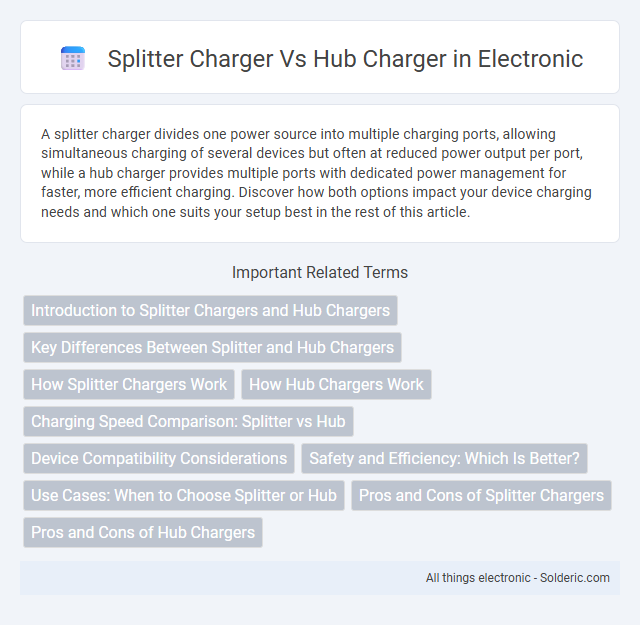A splitter charger divides one power source into multiple charging ports, allowing simultaneous charging of several devices but often at reduced power output per port, while a hub charger provides multiple ports with dedicated power management for faster, more efficient charging. Discover how both options impact your device charging needs and which one suits your setup best in the rest of this article.
Comparison Table
| Feature | Splitter Charger | Hub Charger |
|---|---|---|
| Function | Splits one charger port into multiple charging outputs | Central device with multiple ports for charging several devices simultaneously |
| Power Output | Shares power among outputs, may reduce charging speed | Provides independent power to each port, supports fast charging |
| Number of Ports | Usually 2-3 outputs | Typically 4 or more USB ports |
| Compatibility | Works with single charger, limited device support | Compatible with multiple device types and fast charge standards |
| Portability | Compact and lightweight | Bulkier, less portable |
| Use Case | Quick solution for limited ports | Ideal for charging several devices at home or office |
Introduction to Splitter Chargers and Hub Chargers
Splitter chargers enable multiple devices to charge simultaneously from a single power source by dividing one USB port into several outputs, ideal for managing limited power outlets. Hub chargers expand charging capabilities by integrating multiple ports, often including USB-A, USB-C, and sometimes even power delivery technology, facilitating efficient power distribution for various devices. Understanding the distinctions in power output, port types, and device compatibility is essential for choosing between splitter chargers and hub chargers in multi-device charging scenarios.
Key Differences Between Splitter and Hub Chargers
Splitter chargers divide a single charging port into multiple outputs, allowing simultaneous charging of several devices but often limiting power distribution and speed. Hub chargers provide independently powered ports with advanced power management, delivering higher efficiency and faster charging for multiple devices concurrently. Understanding these differences helps you choose the right charger for your needs, balancing convenience and charging performance.
How Splitter Chargers Work
Splitter chargers work by dividing a single power source into multiple outputs, allowing simultaneous charging of several devices without needing separate chargers for each. These devices efficiently distribute current while maintaining voltage levels to ensure safe and consistent charging across connected gadgets. You can optimize your charging setup by using a splitter charger to reduce clutter and improve power management for multiple devices.
How Hub Chargers Work
Hub chargers function by distributing power from a single AC source to multiple connected devices via various ports, often including USB-A, USB-C, and sometimes AC outlets. They incorporate intelligent power management systems that dynamically allocate current based on each device's requirements, ensuring efficient and safe charging. This centralized approach simplifies cable management and reduces the need for multiple adapters, making hub chargers ideal for users with several devices simultaneously.
Charging Speed Comparison: Splitter vs Hub
Splitter chargers divide a single power source into multiple outputs without boosting overall charging speed, often resulting in slower charging as the available current is shared among devices. Hub chargers feature integrated power management and can deliver optimal current to each port, ensuring faster and more efficient charging compared to splitters. Choosing a hub charger improves your device charging speed by intelligently allocating power, unlike splitters that simply split the output.
Device Compatibility Considerations
Splitter chargers typically support charging multiple devices with similar voltage and current requirements, making them ideal for powering identical gadgets simultaneously. Hub chargers offer broader device compatibility by providing varied ports with different power outputs, accommodating laptops, smartphones, and tablets efficiently. To ensure your devices charge safely and effectively, choose a charger that matches your specific device compatibility needs based on power delivery and connector types.
Safety and Efficiency: Which Is Better?
Splitter chargers provide individual charging outputs for multiple devices but may compromise efficiency and safety due to uneven power distribution and potential overheating risks. Hub chargers are designed with integrated circuits that regulate current flow, ensuring balanced power delivery and enhanced safety by preventing short circuits and overcharging. For optimal charging efficiency and safety, hub chargers are generally superior to splitter chargers.
Use Cases: When to Choose Splitter or Hub
Splitter chargers are ideal for users needing to power multiple smaller devices simultaneously, such as smartphones or wireless earbuds, without requiring high wattage per port. Hub chargers are better suited for environments where combining data transfer and device charging is essential, especially for laptops or tablets connected to peripherals. When device charging demands exceed basic power distribution and data connectivity is necessary, opting for a hub charger provides enhanced functionality over a simple splitter.
Pros and Cons of Splitter Chargers
Splitter chargers offer the advantage of charging multiple devices simultaneously from a single power source, making them ideal for managing several gadgets in one location. However, they may deliver reduced power output per device compared to dedicated chargers, potentially resulting in slower charging times. Users should also be aware of compatibility issues, as some splitter chargers might not support fast-charging protocols for all connected devices.
Pros and Cons of Hub Chargers
Hub chargers offer the convenience of charging multiple devices simultaneously through a single power source, reducing cable clutter and providing organized charging solutions. They may have slower charging speeds per port compared to individual chargers or splitter chargers, as the total power output is divided among connected devices. Your choice depends on prioritizing convenience and organization versus maximum charging speed for each device.
Splitter charger vs hub charger Infographic

 solderic.com
solderic.com